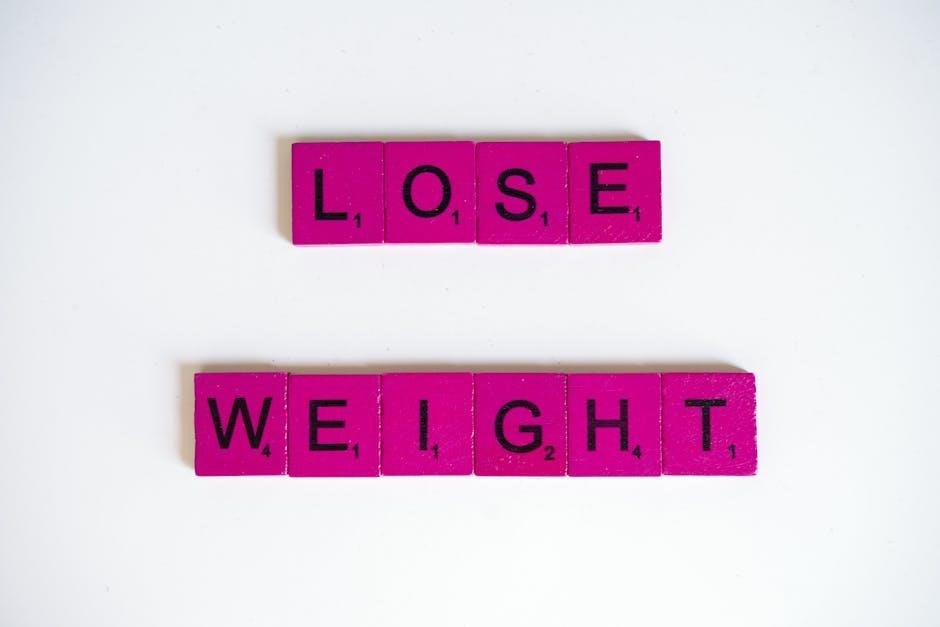
Weighted blankets are innovative tools designed to provide deep pressure stimulation, promoting relaxation and improving sleep quality․ They are often recommended by occupational therapists for their calming effects․
What Are Weighted Blankets and Their Purpose
Weighted blankets are specially designed blankets filled with weighted materials, such as polypropylene pellets, to provide deep pressure stimulation․ This gentle pressure mimics the comforting feeling of a hug, promoting relaxation and reducing stress․ Their primary purpose is to improve sleep quality, alleviate anxiety, and offer a calming sensation․ Occupational therapists often recommend them for individuals seeking a non-invasive tool to enhance emotional and physical well-being․

General Guidelines for Choosing the Right Weight
Choosing the right weight typically starts with 10% of body weight, ensuring safety and effectiveness, then adjusting for personal comfort and specific needs․
The 10% Body Weight Rule
The 10% body weight rule is a widely recommended guideline for selecting a weighted blanket․ For example, a 150-pound person should opt for a 15-pound blanket․ This proportion ensures the blanket provides sufficient deep pressure stimulation without feeling overwhelming․ Occupational therapists often endorse this rule, emphasizing its balance between comfort and therapeutic benefit․ It serves as a reliable starting point for most users, though adjustments may be needed based on personal preferences and specific needs․
Why 10% of Body Weight is Recommended
The 10% rule strikes a balance between safety and effectiveness, ensuring the blanket is heavy enough to provide deep pressure stimulation without causing discomfort․ This proportion is widely considered safe for most users and is effective for reducing anxiety and stress․ It also aligns with expert recommendations, making it a reliable choice for achieving therapeutic benefits while maintaining comfort during sleep or relaxation․
Weight Recommendations by Age Group
Weighted blankets come in various weights to suit different age groups․ Adults typically use 10% of their body weight, while teenagers and children have tailored recommendations based on size and safety considerations․
Adults (18+ Years)
For adults, weighted blankets typically range between 15-25 pounds, based on the 10% body weight rule․ A 150-pound individual might opt for a 15-pound blanket, while a 250-pound person could prefer a 25-pound option․ Personal comfort, sleep preferences, and health conditions like arthritis or mobility issues should guide the choice․ Heavier individuals may find deeper pressure beneficial, but caution is advised to avoid restricting movement or causing discomfort during sleep․
Teenagers (13-17 Years)
Teenagers typically benefit from weighted blankets ranging between 10-15 pounds, based on the 10% body weight rule․ For example, a 130-pound teen might prefer a 13-pound blanket, while a 150-pound teen could opt for a 15-pound option․ Personal comfort and sleep preferences play a significant role, as some teens may find heavier weights too restrictive․ It’s important to balance the calming effects with mobility and comfort to ensure restful sleep without discomfort․
Children (8-12 Years)
For children aged 8-12, weighted blankets are typically recommended at 10% of their body weight, ranging from 5 to 10 pounds․ This ensures safety and comfort while providing the calming benefits of deep pressure stimulation․ Factors like body size, personal comfort, and mobility should be considered․ Parents are advised to consult with an occupational therapist to determine the most suitable weight for their child, ensuring effectiveness and safety․

Factors Influencing Weighted Blanket Weight
Weighted blanket weight is influenced by body weight, height, personal comfort, health conditions, and mobility issues․ These factors ensure the blanket is effective and safe for the user․
Body Weight and Height Considerations
Body weight and height play crucial roles in choosing the right weighted blanket․ Typically, the blanket should be 10% of the user’s body weight, ensuring it provides optimal comfort and pressure without being too restrictive․ Taller individuals may prefer slightly heavier options, while shorter users might find lighter blankets more comfortable․ Proper sizing ensures the blanket remains effective and safe for all users․
Personal Comfort and Sleep Preferences
Personal comfort and sleep preferences significantly influence weighted blanket weight selection․ Some users prefer a lighter blanket for a gentle, calming sensation, while others opt for heavier options to feel more grounded․ Sleep position, whether side, back, or stomach, also matters, as heavier blankets may feel restrictive for certain sleepers․ Individual tolerance to weight varies, making it essential to balance comfort with therapeutic benefits․
Health Conditions and Mobility Issues
Certain health conditions and mobility challenges require careful consideration when choosing a weighted blanket․ For individuals with chronic pain or joint issues, lighter weights may be more comfortable․ Those with limited mobility should opt for blankets that allow easy movement․ Consultation with a healthcare provider is crucial to ensure the weight and design accommodate specific needs without exacerbating existing conditions or restricting movement․

Pros and Cons of Different Weights
Different weighted blanket weights offer unique benefits and drawbacks․ Lighter weights may lack sufficient pressure for some, while heavier weights can cause discomfort for others․
Benefits of Lighter Blankets (7-10% of Body Weight)
Lighter weighted blankets, typically 7-10% of body weight, offer gentle pressure ideal for sensitive individuals or those new to weighted blankets․ They promote relaxation without feeling overwhelmed, making them suitable for restful sleep and daily use․ Users with mobility issues often prefer lighter options for easier movement․ This range is also recommended for teenagers and lighter adults seeking comfort without heaviness․
Benefits of Heavier Blankets (10-15% of Body Weight)
Heavier weighted blankets, ranging from 10-15% of body weight, provide intense deep pressure stimulation, which can enhance grounding and relaxation․ They are ideal for individuals who prefer a stronger sensory input, often benefiting those with severe anxiety or insomnia․ However, they may feel too heavy for some users, particularly those with mobility issues or lighter body frames, so personal comfort should be prioritized․
Drawbacks of Using the Wrong Weight
Using a weighted blanket that is too heavy or too light can lead to discomfort, restricted movement, or reduced effectiveness․ A blanket that is too heavy may cause strain or difficulty breathing, while one that is too light may fail to provide sufficient deep pressure stimulation․ Incorrect weight can also exacerbate health conditions or mobility issues, making it essential to choose a weight that aligns with personal comfort and therapeutic needs․

Safety Considerations
Weighted blankets can pose risks if not used properly․ Occupational therapists recommend consulting a healthcare professional before use, especially for individuals with certain health conditions or mobility challenges․
Who Should Avoid Weighted Blankets
Certain individuals should avoid weighted blankets, including young children under eight years old, as they may pose a suffocation risk․ People with severe respiratory issues, mobility challenges, or chronic health conditions should also avoid them unless advised by a healthcare professional․ It’s crucial to consult a doctor for personalized safety guidelines to ensure safe usage․
How to Use a Weighted Blanket Safely
To use a weighted blanket safely, choose one recommended by manufacturers or therapists, ensuring it suits your body weight and age․ The blanket should be designed for one person to avoid discomfort․ Avoid overheating by using a breathable cover or a lighter blanket in warmer climates․ Always consult a healthcare professional if you have underlying health conditions․ Proper use enhances relaxation and sleep quality effectively․
Real-Life Experiences and Feedback
Users share mixed experiences, with many praising weighted blankets for improving sleep and relaxation, while others note challenges with weight distribution and overheating concerns․
Common User Testimonials
Many users praise weighted blankets for enhancing sleep quality and reducing anxiety, while others highlight concerns about weight distribution and overheating․ A 15-pound blanket user shared it was “amazing” for relaxation but caused hip discomfort due to weight; Overall, testimonials reveal a balance of benefits and challenges, emphasizing the importance of choosing the right weight for individual comfort and needs․
Lessons Learned from User Reviews
User reviews highlight that weighted blankets can significantly improve sleep and reduce anxiety, but individual preferences vary widely․ Many find the 10% body weight rule a good starting point, while others prefer lighter or heavier options․ Some users report discomfort due to excessive weight, emphasizing the importance of personalization․ Health conditions and mobility issues also play a crucial role in determining the ideal weight, underscoring the need for careful consideration before purchase․
Choosing the right weighted blanket weight involves balancing personal comfort, health needs, and the 10% body weight rule․ Experimentation and professional guidance can ensure optimal benefits and safety․
Final Thoughts on Choosing the Right Weight
Choosing the right weighted blanket weight is a personal process that balances the 10% body weight rule with individual comfort and health considerations․ While the 10% guideline is a reliable starting point, factors like sleep preferences, mobility, and medical conditions can influence the ideal weight․ It’s essential to prioritize comfort and safety, as a blanket that’s too heavy can cause discomfort․ Experimenting with different weights and consulting occupational therapists can help ensure the best experience․ Always prioritize your well-being and adjust as needed to maximize the calming benefits of a weighted blanket․
Encouragement to Experiment and Adjust
Experimenting with weighted blanket weights is key to finding your perfect match․ Start with a lighter option and gradually increase if needed․ Remember, preferences may evolve, so it’s okay to adjust․ Don’t hesitate to try different weights or consult professionals for guidance․ Your comfort and sleep quality are worth the exploration․ Embrace the process, and enjoy the journey to finding your ideal weighted blanket․